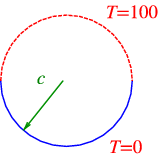8.1: Example
( \newcommand{\kernel}{\mathrm{null}\,}\)
Consider a circular plate of radius c \text{ m}, insulated from above and below. The temperature on the circumference is 100^\circ~\text{C} on half the circle, and 0^\circ~\text{C} on the other half.

The differential equation to solve is \rho^2 \frac{\partial^2 u}{\partial \rho^2} + \rho \frac{\partial u}{\partial \rho} + \frac{\partial^2 u}{\partial \phi^2}{u} = 0, \nonumber with boundary conditions u(c,\phi) = \begin{cases} 100 & \text{if $0 < \phi < \pi$} \\ 0 & \text{if $\pi < \phi < 2\pi $} \end{cases}\quad . \nonumber
8.1.1: Periodic BC
There is no real boundary in the \phi direction, but we introduce one, since we choose to let \phi run from 0 to 2\pi only. So what kind of boundary conditions do we apply? We would like to see “seamless behaviour”, which specifies the periodicity of the solution in \phi, \begin{aligned} u(\rho,\phi+2\pi)&=u(\rho,\phi),\\ \frac{\partial u}{\partial \phi}(\rho,\phi+2\pi)&=\frac{\partial u}{\partial \phi}(\rho,\phi).\end{aligned} \nonumber If we choose to put the seem at \phi=-\pi we have the periodic boundary conditions \begin{aligned} u(\rho,2\pi)&=u(\rho,0),\\ \frac{\partial u}{\partial \phi}(\rho,2\pi)&=\frac{\partial u}{\partial \phi}(\rho,0).\end{aligned} \nonumber
We separate variables, and take, as usual u(\rho,\phi) = R(\rho) \Phi(\phi). \nonumber This gives the usual differential equations \begin{aligned} \Phi''-\lambda\Phi &=0,\\ \rho^2 R'' + \rho R' + \lambda R &= 0.\end{aligned} \nonumber Our periodic boundary conditions gives a condition on \Phi, \Phi(0)=\Phi(2\pi),\;\;\Phi'(0)=\Phi'(2\pi). \label{eq:phiBC} The other boundary condition involves both R and \Phi.


